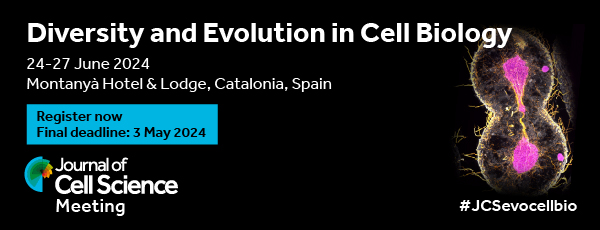Issues
-
Cover image
Cover Image

Cover: Rabgap1 functions as an important factor for conformation-specific integrin trafficking. Silencing Rabgap1 in mouse fibroblasts leads to the intracellular accumulation of active β1 integrins, alters focal adhesion formation and decreases cell migration. This immunofluorescence image depicts a Rabgap1-depleted mouse fibroblast stained for F-actin (red) to visualise the actin cytoskeleton and paxillin (magenta) to label cell–matrix adhesions. The cell nucleus is stained with DAPI (blue). See article by A. V. Samarelli et al. (jcs243683).
- PDF Icon PDF LinkTable of contents
- PDF Icon PDF LinkIssue info
RESEARCH HIGHLIGHTS
EDITORIAL
STICKY WICKETS
FIRST PERSON
REVIEWS
Functions of Wnt and Hedgehog-containing extracellular vesicles in development and disease
Summary: We discuss perspectives on the mechanisms of formation of Wnt- and Hedgehog-containing extracellular vesicles, and their functions in development and various human pathologies.
The ESCRTs – converging on mechanism
Summary: New structural and biophysical studies have shed much light on the physical mechanism of ESCRT-mediated membrane remodeling and scission.
The basement membrane as a structured surface – role in vascular health and disease
Summary: This Review explores the emerging role of the biophysical properties of the basement membrane in regulating critical aspects of vascular health and disease.
New insights into non-transcriptional regulation of mammalian core clock proteins
Summary: In this Review, we highlight recent work identifying non-transcriptional mechanisms crucial to regulating the core mammalian clock proteins and their role in circadian rhythmicity.
SHORT REPORTS
Myosin 1b flattens and prunes branched actin filaments
Summary: In vitro F-actin gliding assays and TIRF microscopy reveal that myosin flattens the Arp2/3-dependent actin branches up to the point of them breaking, and reduces the probability that new branches are formed.
Phosphoregulation of the cytokinetic protein Fic1 contributes to fission yeast growth polarity establishment
Summary: Complex phosphoregulation of the S. pombe contractile ring protein Fic1 influences polarity establishment and the transition from a unicellular state into a state with invasive pseudohyphal growth.
RESEARCH ARTICLES
Increased supraorganization of respiratory complexes is a dynamic multistep remodelling in response to proteostasis stress
Summary: Cells remodel respiratory complex organization depending on metabolic status. Here, using a two-dimensional complexome profiling strategy, we propose a biphasic mechanism for this remodelling during proteostasis stress.
Intraflagellar transport during assembly of flagella of different length in Trypanosoma brucei isolated from tsetse flies
Summary: Investigation of intraflagellar transport in several trypanosome developmental stages extracted from tsetse flies provides new insights into mechanisms controlling flagellum length.
Rabgap1 promotes recycling of active β1 integrins to support effective cell migration
Highlighted Article: The β1 integrin interactor Rabgap1 promotes recycling of active β1 integrins from endosomes to enhance cell migration on 2D surfaces as well as cell invasion into a 3D matrix.
Role of a versatile peptide motif controlling Hox nuclear export and autophagy in the Drosophila fat body
Summary: A generic Hox peptide works as an unconventional nuclear export signal (NES) to control Hox nuclear export and developmental autophagy in the Drosophila larval fat body.
A discrete interface in matrix stiffness creates an oscillatory pattern of endothelial monolayer disruption
Highlighted Article: Transitions in matrix stiffness create oscillatory patterns of endothelial monolayer barrier disruption and cell contractility.
Mitochondrial import, health and mtDNA copy number variability seen when using type II and type V CRISPR effectors
Summary: Testing the targeting and tolerance of CRISPR effectors and gRNAs in mammalian cell lines towards the design of functional MitoCRISPR tools.
ACSL3 is a novel GABARAPL2 interactor that links ufmylation and lipid droplet biogenesis
Highlighted Article: Using endogenous tagging and interaction proteomics, we identified the ER-associated lipid droplet biogenesis factor ACSL3 as a GABARAPL2-binding partner that serves as novel regulator of the enigmatic UFM1 conjugation pathway.
APC/CCdh1 is required for the termination of chromosomal passenger complex activity upon mitotic exit
Summary: APC/CCdh1 ubiquitylates both borealin, via a non-canonical degron motif, and Aurora B to terminate activity of the CPC in G1 phase. Disruption of this ubiquitylation reduces the efficiency of DNA replication.
Role of the Sec22b–E-Syt complex in neurite growth and ramification
Summary: The non-fusogenic Sec22b–Stx1 SNARE complex contributes to plasma membrane expansion by interacting with the E-Syt lipid transfer proteins at ER–PM contact sites.
Microtubule polyglutamylation is important for regulating cytoskeletal architecture and motility in Trypanosoma brucei
Summary: An imbalance of microtubule polyglutamylation leads to the disintegration of the posterior cytoskeleton and alterations of the swimming behaviour from a directional into a non-directional, diffusive mode in Trypanosoma brucei.
An indispensable role for dynamin-related protein 1 in beige and brown adipogenesis
Summary: The mitochondrial fission protein dynamin-related protein 1 (DRP1) plays an essential role in early transcriptional reprogramming during beige and brown adipocyte differentiation.
TOOLS AND RESOURCES
Synchronization of human retinal pigment epithelial-1 cells in mitosis
Summary: A new methodology to synchronize RPE-1 cells in mitosis for large-scale biochemical and proteomics studies.
Introducing our new Editors

We welcome three new Editors to Journal of Cell Science - Robert Parton, Richa Rikhy and Simon Cook. You can read more about them in the Editorial from our Editor-in-Chief Michael Way.
2024 Journal Meeting 'Diversity and Evolution in Cell Biology'

Registration is open for our 2024 Journal Meeting Diversity and Evolution in Cell Biology, which aims to bring together evolutionary biologists and cell biologists investigating diverse aspects of cellular physiology. Final registration deadline: 3 May 2024.
Workshop: Physics of the Early Embryonic Cell Divisions

Early-career researchers interested in the roles of nuclear lipids, apply now for one of the ten funded places at this Workshop, which will take place 11-14 November 2024. Application deadline: 17 May.
Reasons to submit to Journal of Cell Science

There are many benefits to publishing in Journal of Cell Science - read more about why you should choose JCS or visit our submission page now.
Propose a new Workshop for 2026

We are now accepting proposals for our 2026 Workshops programme. We aim to be responsive to the community and open to novel initiatives, so if you have a new idea for a biological workshop that you feel would work well, please apply. Applications deadline: 19 July 2024.



